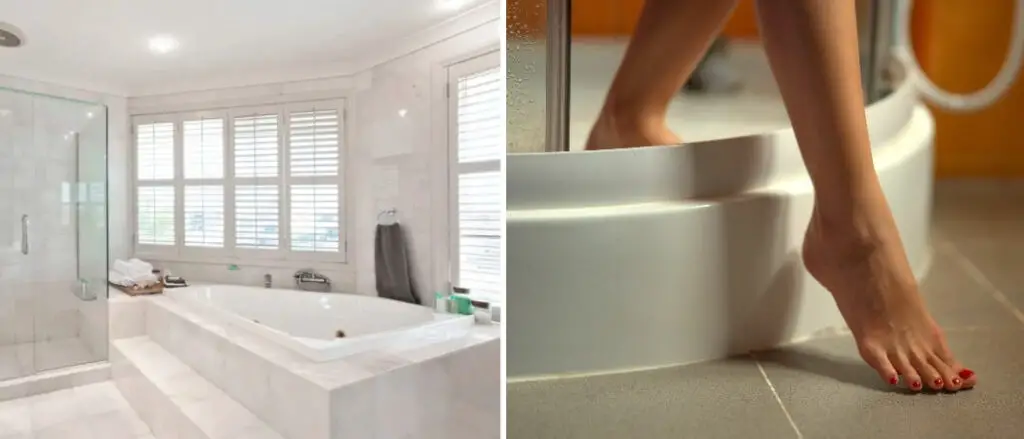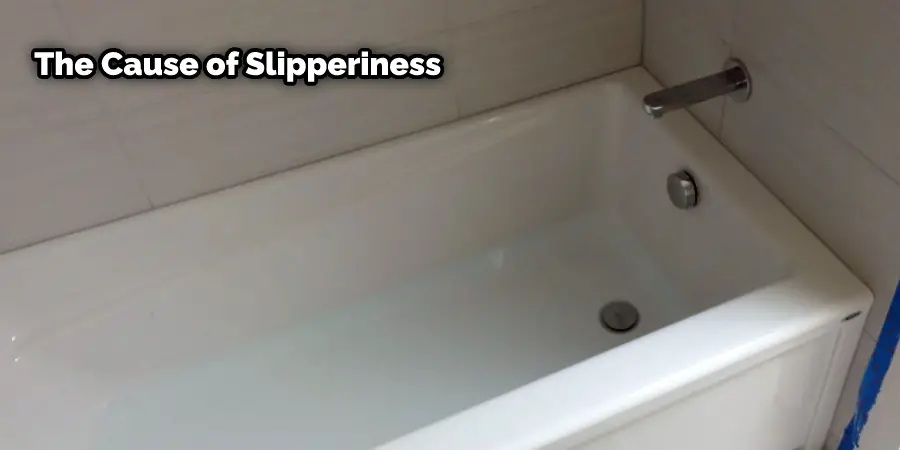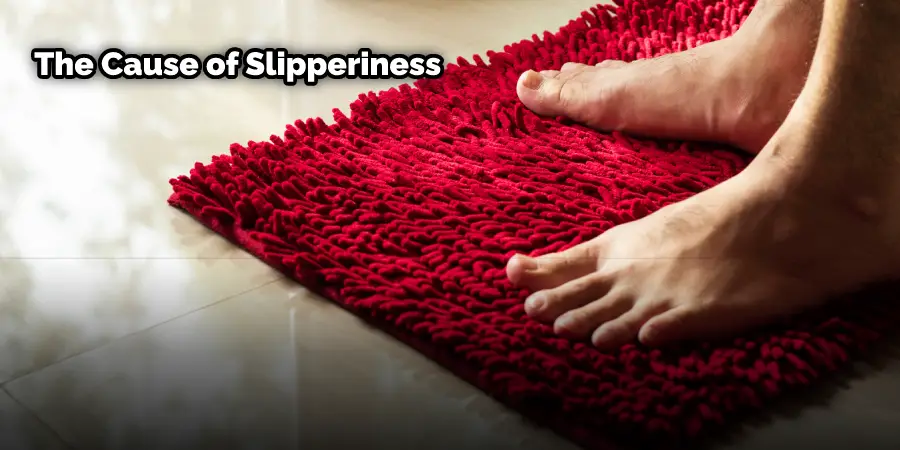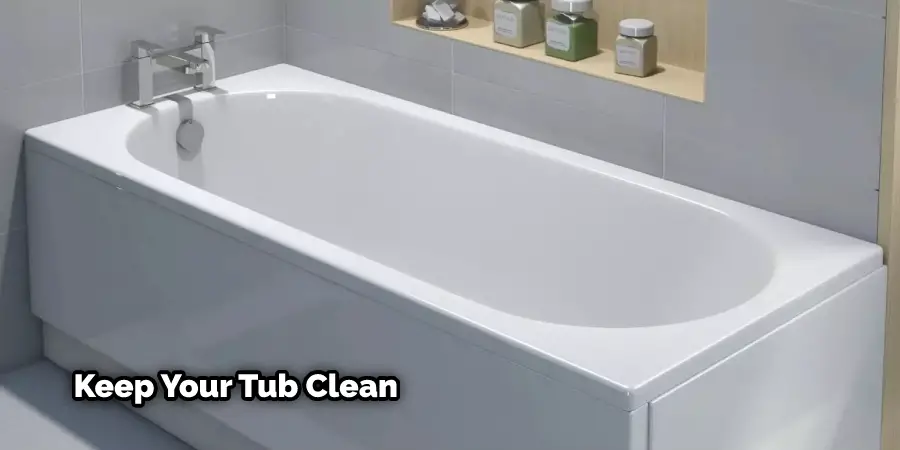Slippery baths and showers are dangerous, especially if you have young children in the house. Not only is it a risk when you enter your shower or bathtub, but even more so when you come out. Slipping on wet tiles can lead to nasty falls and even injuries that might require medical attention. So what should you do if your bathroom is slippery? We’ve got all the details here to help make sure that your bathrooms stay functional and safe! Read on for our guide to fixing a slippery tub.

So, keep reading to learn about how to fix a slippery tub.
Identify the Cause of Slipperiness
A slippery tub can be a hazard, causing falls and injuries. To fix a slippery tub, it’s important to identify the cause of the slipperiness. Here are some of the most common factors that can contribute to a slippery tub and how to diagnose the problem:

1. Soap Scum:
Soap scum is a buildup of soap and body oils that can accumulate on the surface of a tub over time. It can make the surface of the tub slippery and difficult to clean. To diagnose soap scum as the cause of slipperiness, run your hand over the surface of the tub. If it feels slimy or slippery, it’s likely that soap scum is the culprit.
2. Hard Water Deposits:
Hard water contains minerals such as calcium and magnesium that can build up on the surface of a tub, creating a rough and slippery surface. To diagnose hard water deposits as the cause of slipperiness, look for a whitish or grayish film on the surface of the tub.
3. Smooth Surface:
Some tubs are simply too smooth, making them prone to slipperiness even when they are clean. To diagnose a smooth surface as the cause of slipperiness, run your hand over the surface of the tub. If it feels slick and slippery even when it’s clean, it’s likely that the surface of the tub is too smooth.
4. Oily or Greasy Products:
Using oily or greasy products in the tub, such as bath oils or body lotions, can leave a residue on the surface of the tub that can make it slippery. To diagnose oily or greasy products as the cause of slipperiness, look for a slick or oily film on the surface of the tub.
5. Mold and Mildew:
Mold and mildew can also be a cause of slipperiness in the tub. To diagnose mold or mildew as the cause of slipperiness, look for dark spots or slimy patches on the surface of the tub.
Once you’ve identified the cause of the slipperiness, you can take steps to fix the problem. Depending on the cause, solutions may include cleaning the tub with a specific cleaning solution, using an anti-slip mat or applying a non-slip coating, or simply avoiding the use of oily or greasy products in the tub.
10 Ways How to Fix a Slippery Tub
1. Clean the Tub
The first step in fixing a slippery tub is to clean it thoroughly. Use a cleaner specifically designed for removing soap scum, hard water deposits, and other grime. Allow the cleaner to sit on the surface of the tub for several minutes before rinsing it off with warm water. Repeat this process until the tub is completely clean.
2. Use Non-Slip Mats or Stickers
For a quick fix, consider using non-slip mats and stickers to make the surface of the tub less slippery. These are designed to provide extra grip so that you don’t slip while in the tub. Non-slip mats and stickers come in a variety of colors and designs, so you can find one that fits your style.
3. Apply a Non-Slip Coating
Some tubs come with an anti-slip coating already applied to the surface. If yours does not have one, consider applying a non-slip coating yourself to make the tub less slippery. Non-slip coatings are available in liquid or spray form and can be found at most home improvement stores. Follow the instructions on the package for the best results.
4. Use Mild Abrasive Cleaners
If a non-slip coating isn’t enough to make your tub less slippery, try using a mild abrasive cleaner. Abrasive cleaners are designed to remove soap scum and hard water deposits while providing extra grip on the surface of the tub.
5. Use a Quality Bath Mat
Using a bath mat is an easy way to make your tub less slippery and prevent falls and injuries. Make sure to choose one with a non-slip back that will stay in place while you’re in the tub.
6. Use Anti-Slip Additives
Some products, such as paint and grout, can be made more slip-resistant by adding anti-slip additives. These additives come in powder form and can be added to the product before it is applied to the surface of the tub.

7. Use Sandpaper
If you have a textured tub but still find that it’s slippery, consider using sandpaper to make the surface rougher and less slippery. Start with a coarse-grit sandpaper and work your way up to finer grits to get the desired results.
8. Apply a Textured Coating
Another option is to apply a textured coating to the surface of your tub. These coatings come in a variety of textures, such as sandstone or pebble, and can provide extra grip and traction on slippery surfaces.
9. Use Slip-Resistant Strips
Slip-resistant strips are plastic or rubber strips that can be applied to the surface of your tub. They come in a variety of sizes and can provide extra grip on slippery surfaces.
10. Use Tape or Adhesive Strips
If all else fails, you can use adhesive tape or strips to make your tub less slippery. These come in a variety of sizes and colors, so you can find one that fits your style. Keep in mind that these are only temporary solutions and will eventually wear off over time.
These are just some of the ways to fix a slippery tub. Remember to follow all instructions carefully when using any cleaning products or solutions, and to avoid using slippery or oily products in the tub. With a few simple steps, you can make your bathtub safer and less slippery for everyone in your household.
Additional Tips While Fixing Slippery Tub
1. Test the Surface of Your Tub with Water Before Using It:
Before you use any cleaning products or solutions to make your tub less slippery, test the surface with a few droplets of water. If the water beads up and doesn’t spread out quickly, then the surface is already non-slip, and you don’t need to take any further action.
2. Avoid Using Oils or Slippery Products in the Tub:
Oils and other slippery products can make your tub more dangerous by making it even slipperier! Avoid using any oils or soaps that contain oil, as well as bubble baths or any other product with a slippery texture.
3. Keep Your Tub Clean:
Regularly clean your tub to remove any build-up of soap scum, dirt, or other debris that can make the surface slippery. Use a non-abrasive cleaner and scrub brush for best results.

4. Make Sure Your Drain is Working Properly:
A clogged or slow-moving drain can cause water to pool in the bottom of the tub, which can increase the risk of slipping. Make sure your drain is working properly and that all excess water is quickly drained away.
5. Have Someone Spot You:
If you’re worried about slipping in the tub, having someone spot you may be a good idea. This can provide extra peace of mind and make relaxing while enjoying your bath easier.
6. Take Your Time Getting Out of the Tub:
When exiting the tub, take your time and move slowly and deliberately. This will help you stay in control and reduce the chance of slipping or falling.
7. Seek Medical Help If You’ve Injured Yourself:
If you do slip and fall, seek medical attention if needed. Even if the injury does not appear serious, it is better to be safe than sorry.
8. Invest in Non-Slip Mats:
Non-slip mats are an inexpensive and effective way to make your tub less slippery. They can be placed directly on the surface of the tub and provide extra grip for those getting in and out of the tub. They’re also easy to clean and can be replaced when they become worn out.
Follow these additional tips, along with the steps above, to make your tub less slippery and greatly reduce the chance of slipping or falling.
How to Maintain Tub so That It Does Not Get Slippery Easily
Regularly clean the tub with a mild soap or detergent, and rinse it with warm water. Make sure to scrub any areas where dirt and grime accumulate. After cleaning, dry the bathtub surface thoroughly with a soft cloth so that there is no water left on the surface.
Be sure to replace any worn-out mats and treads regularly. For more protection, you can use a clear anti-slip coating on the surface of your tub. This will also help protect it against wear and tear.
If you have a textured bathtub, use a soft-bristled brush or sponge to scrub it clean, making sure to rinse thoroughly between each cleaning session. Make sure that all soapy residue is gone before drying off the area in order to prevent it from becoming slippery.
Regularly inspect the bathtub for any signs of wear and tear, particularly near drains and spouts, as these areas are more likely to become slippery. If you find that the surface has become damaged, replace or repair it immediately to keep your tub safe and slip-resistant. Finally, ensure that your tub is well-ventilated during and after use to prevent mold, mildew, and bacteria from growing on the surface. Keeping your tub clean and dry will help keep it slip resistant for longer.
Following these tips can help you maintain your bathtub so that it does not become slippery easily. As with any bathroom item, regular cleaning and maintenance are essential for keeping your bathtub safe and slip-free. If you have any questions or concerns about your tub’s condition, consult a professional for advice. Taking the time to care for your bathroom fixtures will help ensure that they remain safe and functional for years to come.
Conclusion
Taking care of your tub regularly with mild soap and detergent, adding rubber mats or non-slip treads, cleaning any textured surfaces with a soft brush, replacing worn items regularly, inspecting the surface for damage, and ensuring proper ventilation after use are all important steps to take when it comes to preventing slippery bathtubs. By taking these steps, you can ensure that your tub remains safe and slip-resistant for a longer period.
Finally, if you have any questions or concerns about the condition of your bathtub, it is best to consult a professional for advice. Remember, taking the time to care for your bathroom fixtures will help keep them in good condition for years to come. Thanks for reading this article about how to fix a slippery tub.
